Introduction
On the Bell Rock
Robert Clyne
John Henderson
Dangerous Work
The Keepers
Further Resources
Introduction
Lightkeepers once served up and down the coastline of Scotland, manning lighthouses to shine a guiding light to vessels traversing the seas and looking to return to harbour. While the lighthouses remain, the majority of lightkeepers have long since retired as the process of automation was completed in March 1998. Despite this, the story of lightkeepers, their role and how they lived still fascinate, as many imagine their day-to-day activities, on isolated and weather-battered towers. Families continue to research and pass down the stories of their lightkeeper ancestors, and the pivotal role they played in protecting the lives of sailors.
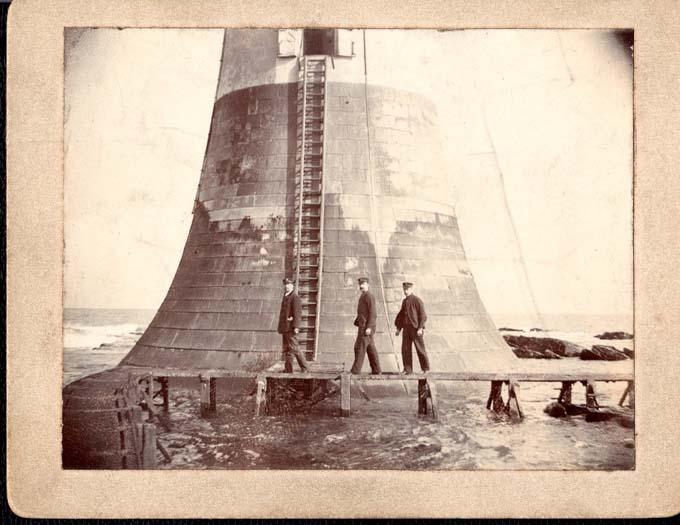
Three Lightkeepers outside of The Bell Rock Lighthouse. One is believed to be John Henderson (1864-1939), c1900-1919.
Courtesy of the Morrison Family.
Four volumes, spanning a total of 84 years (1837-1921) from the Lightkeeper Registers of the Commissioners of Northern Lighthouses, have now been imaged and are available on the National Records of Scotland’s service, Scotland's People. These registers are indexed and can be searched by name, age and the year an individual entered into service. For those interested in a particular area, you can also search by the lighthouse name, county or locality.
The registers give the career histories for each keeper, noting their full name, often their date of birth, the lighthouses they served in, promotions, demotions and their retirement date.
So what of the lightkeeper role? Lightkeepers were divided into two grades: the Principal Lightkeeper and Assistant Lightkeeper. Their primary duties were to keep the light and fog signal in working order. The Keepers would take shifts to keep watch and ensure the light was working correctly. Other daily activities included cleaning and maintaining the station. At Rock Stations, such as the Bell Rock or Skerryvore, there would be six lightkeepers, with three on the rock while on duty, and three having time ashore.
On the Bell Rock
The Bell Rock Lighthouse is the oldest sea-washed lighthouse in the world. Situated on the Inchcape Rock, or Bell Rock as it is known, the lighthouse was built to guide ships around this treacherous reef. Until the lighthouse’s construction, the rock remained a significant danger to navigators because it was overflowed and often obscured from view during each tide.
Three keepers would be on duty at the Bell Rock, originally for six weeks, followed by two onshore. Over time this changed to two months on, one month off, and by the 1970s, one month on and one month off. At night, shifts of three or four hours would be taken to ensure that the clockwork mechanism, that turned the lamp and rang the bells, was wound up every 30 minutes.
Between their night shifts, each keeper slept in one of the three bunks available, one on top of the other, in a 13-foot circular room, with a curtain provided for privacy. The keeper on the night watch previous would make breakfast for all of the men. The day would then be spent cleaning, repairing and maintaining the tower itself. This included the daily measurement of important stores, such as oil, paraffin and water. As contact with the shore, and access by boat could be restricted by weather, it was important to effectively ration these supplies. This meant that there was no shower or bath for the duration of the lightkeepers’ stay on the rock. Similarly, the lighthouse did not have a toilet until 1964 when a saltwater unit was installed. It is easy to imagine the relief of those on shift when returning to shore and having access to a fully equipped bathroom!

Living in close quarters. The Keepers of the Bell Rock, c1900
Image courtesy of the Morrison Family.
Robert Clyne
Robert Clyne was born 14th March 1858 in the Parish of Kirriemuir to Alexander Clyne, an agricultural labourer, and Charlotte Clyne (née Simpson). On 15th June 1883, Robert married Isabelle Davidson, a domestic servant. His usual residence at the time was recorded as the ‘Lighthouse, Isle of Man’ and his role was that of a ‘Lighthouse Keeper’.
From the recently released registers we can track Robert’s career, from his entry as an Assistant Lightkeeper, to his promotion to Principal on 26th August 1895.

Robert Clyne's entry in the lightkeepers' register
Crown copyright, National Records of Scotland, NLC4/1/3 image 159
From this we can see that Clyne spent 7 years and 8 months on the Bell Rock. The lighthouse is 11 miles from the shores of Arbroath, and to the men working on the rock, assistance in times of need must have seemed very far away. Originally, there was no telephone, and the ability to reach the lighthouse by boat was not guaranteed. As such, the construction of a Signal Tower was vital.
Robert Stevenson (1772-1850) instructed that a shore station was built, close to the harbour and in direct line of sight of the lighthouse. The Signal Tower, now home to the excellent museum about the Bell Rock, was completed in 1813. A series of buildings, they were home to the lightkeepers and their families until 1953.
The 1901 census enumerates Robert Clyne and his extensive family, as well as those of the other lightkeepers, at the Signal Tower.
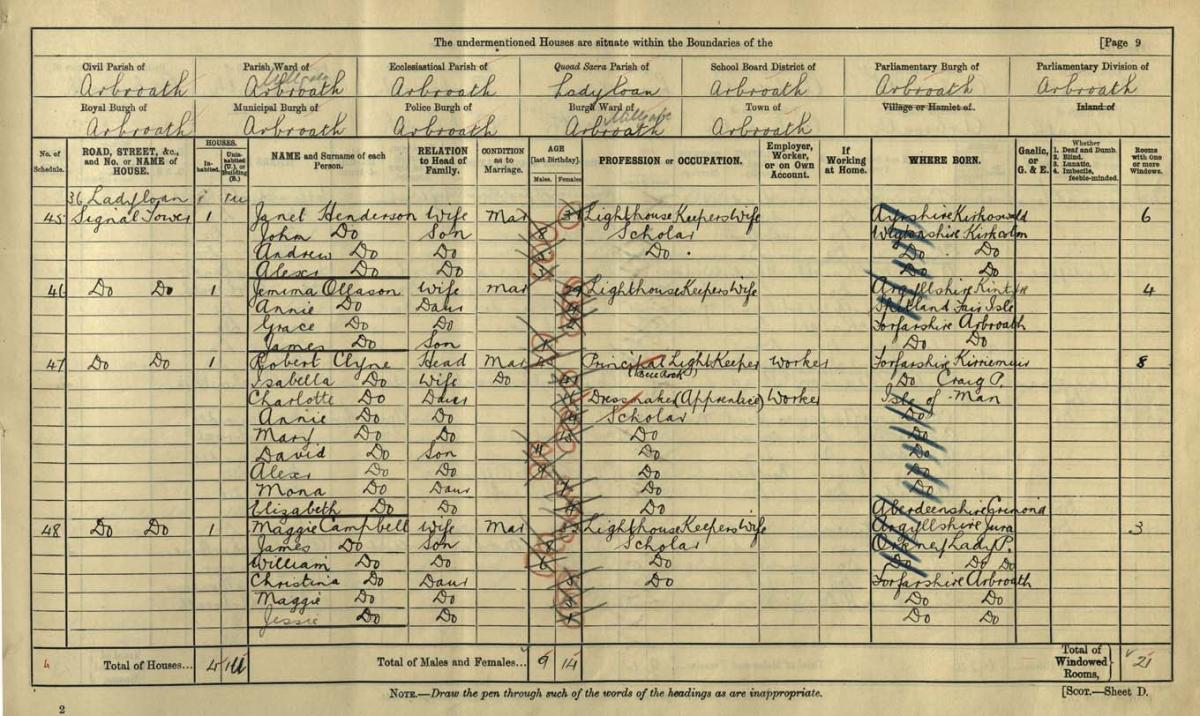
The Clyne family enumerated at ’47 Signal Tower’ in Arbroath in the 1901 census.
Crown copyright, National Records of Scotland, 272/1 3 page 9
The Signal Tower communicated by flying flags, and by the raising and lowering of a large copper ball. It is said in Arbroath, that when a keeper’s wife was expecting a baby, if he was stationed on the rock when she gave birth, a pair of trousers, or a dress would be flown from the Signal Tower flagpole, to the let the father know whether it was a boy or a girl!
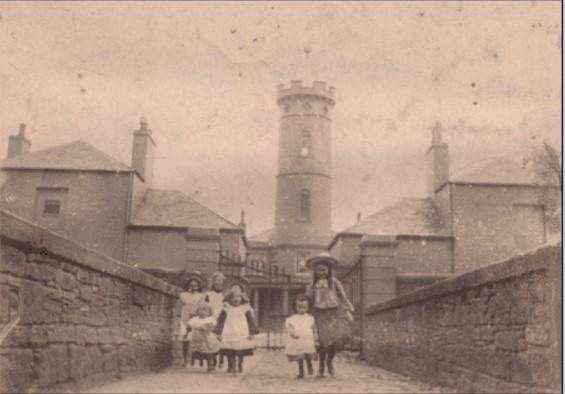
The lightkeeper’s children at the Signal Tower, Arbroath. The girl on the right (wearing the hat) is believed to be the daughter of Robert Clyne, c.20th century.
Courtesy of Jane Bain
John Henderson

John Henderson, believed to be the far right, atop The Bell Rock Lighthouse.
Courtesy of the Morrison Family
John Brown Henderson was born 6 February 1864 in the Parish of Dunfermline to John Henderson, Railway Surfaceman and Margaret Henderson (née Brown). He married Janet Girvan on 17th January 1890 with his usual residence noted as ‘Fiddrie Lighthouse’.
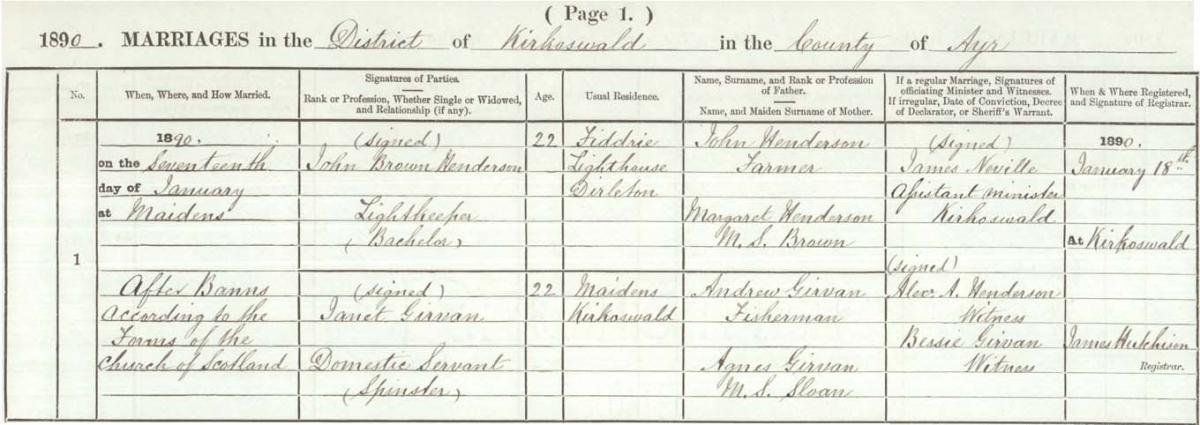
The marriage entry for John Brown Henderson and Janet Girvan, 17th January 1890.
Crown copyright, National Records of Scotland, Statutory Register of Marriages, 1890, 601/1 page 1
Like Robert Clyne, Henderson served on the Bell Rock and the Signal Tower was their home for a number of years. The Lightkeeper Registers tell us, that at one time Henderson was a ‘Power loom tuner’ and that he served on the Bell Rock for 6 years and 9 months from 8 March 1900 as an Assistant Lightkeeper, and as a Principal for 4 years from 26 November 1916.
During the First World War, the light of the lighthouse was extinguished and only exhibited upon request when allied ships were expected to pass. On the 27th October 1915, the Captain of the HMS Argyll, a Devonshire Class Armoured Cruiser, sent out a routine message requesting that the Bell Rock be lit. However, the message was never received. The lighthouse had no radio, and rough seas made it impossible to deliver the message by boat. The “Argyll” struck the reef on the West side and became lodged within 420 feet of the base of the tower. So terrible was the weather, that the ship’s crew was unable to alert the lightkeepers and had to wait until the morning to be spotted. It is possible that John Henderson was on duty to discover the ship in the morning, and worry whether it was an ally, or a German cruiser!
Fortunately there were no casualties among the 655 men aboard.
Dangerous Work
Working in a lighthouse was not without its risks. Accidents could happen within the building, and of course working outside near rough seas, could be dangerous.
Perhaps one of the most famous, and ultimately unresolved, incidents was that of the Flannan Lighthouse.
The Flannan Isles are 21 miles west of the Isles of Lewis, sometimes known as the Seven Hunters. The lighthouse is situated on the largest of the island group on the 38-acre Eileen Mor (Big Island). The white tower, 75 feet tall, sits atop a 200 foot cliff. While the lightkeepers were working, their families resided at Breasclete in Loch Roag, at the shore station.
The Flannan Lighthouse was operational for a little over a year when the Keepers disappeared in December 1900. On 15th December, a passing steamer noted in its log that the light was not working.
When the Hesperus arrived to make the usual relief, the station was found to be deserted, with the lamps trimmed and ready, the lens and machinery cleaned, the kitchen tidied and two sets of outdoor clothing missing. No trace of the men was discovered and further investigations did not resolve the matter.
The Keepers
Though three men dwell on Flannan Isle
To keep the lamp alight,
As we steer’d under the lee, we caught
No glimmer through the night
Flannan Isle, by WW Gibson
James Ducat, was the Principal Lightkeeper on duty at the time. From the Lightkeeper Registers we know that Ducat entered the service on 21st November 1878, aged 22. As an Assistant Lightkeeper he worked at: Montroseness, Inchkeith, Rhins of Islay and Langness. On 2nd May 1896 he was promoted to Principal Keeper at Loch Ryan, and finally served on the Flannan Isles. The final entry in the register has noted underneath it, ‘Disappeared on or about 15 December 1900’.

Information recorded on James Ducat’s time as a Principal Lightkeeper in the Lightkeeper Registers.
Crown copyright, National Records of Scotland, NLC4/1/3 (page 162)
At the time, Ducat was serving with Assistant Lightkeeper Thomas Marshall, and Occasional Keeper Donald McArthur, who was covering the duty for another assistant keeper – William Ross – who was off sick. All disappeared.
All three are recorded in the register of deaths for the district of Carloway, with the cause of death noted as ‘probably drowning’.
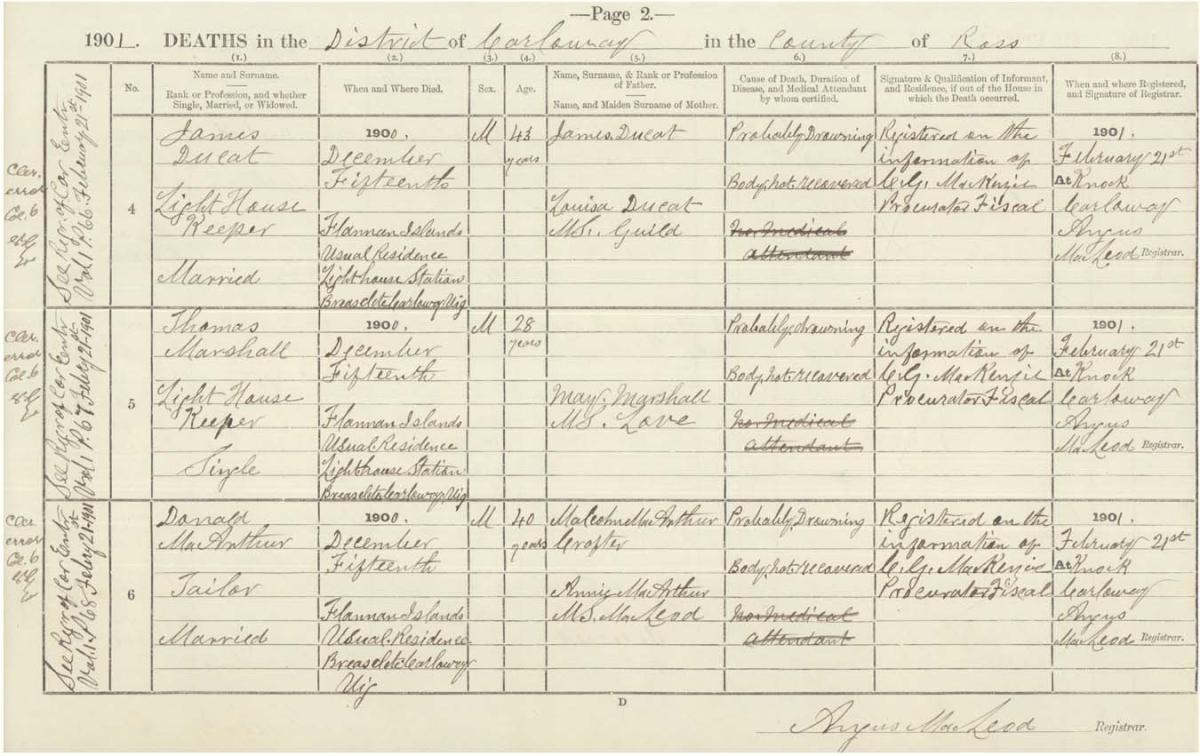
The entries for Ducat, Marshall and MacArthur in the register of deaths, 1901.
Crown copyright, National Records of Scotland, 086/B5 page 2
To explore the Lightkeeper Registers and discover your ancestors, read the guide on Scotland's People which explains the information they hold, and how to use them. To find out more about other records relating to lighthouse keeping in the National Records of Scotland, explore our Lighthouses Research Guide.
Further Resources
- Bellrock.org.uk, an excellent reference site for the Bell Rock Lighthouse
- The Museum of Scottish Lighthouses
- The Signal Tower Museum, Arbroath
- Northern Lighthouse Board